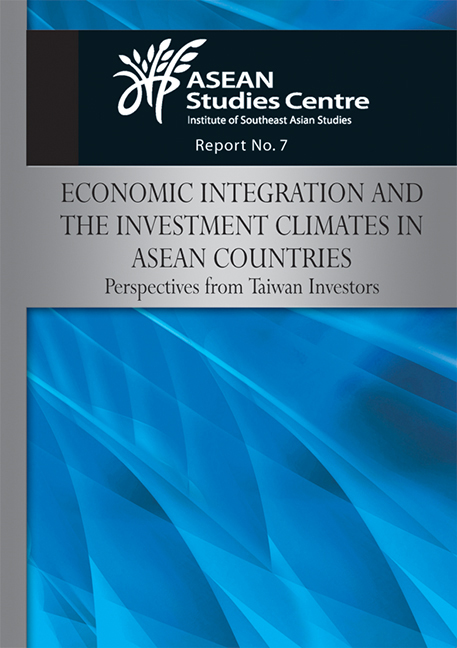 Economic Integration and the Investment Climates in ASEAN Countries
Economic Integration and the Investment Climates in ASEAN Countries from II - Background Papers
Published online by Cambridge University Press: 21 October 2015
This paper seeks to give an update on the ASEAN Economic Community and to discern how Taiwanese and other foreign companies can profit from investing in or otherwise dealing with that community.
ASEAN Vision 2020 of 1997 foreshadowed the aspiration for an ASEAN Economic Community without calling it that. That document declared, “We will create a stable, prosperous and highly competitive ASEAN Economic Region in which there is a free flow of goods, services and investments, a freer flow of capital, equitable economic development and reduced poverty and socio-economic disparities.” It then committed the ASEAN members to undertake a list of measures for realizing that vision.
ASEAN Vision 2020 was issued by ASEAN's leaders in December 1997, at the height of the Asian financial crisis then, and can, therefore, be said to have been an ASEAN response to that crisis. A little more than four years before, in January 1992, ASEAN had entered into an agreement to reduce tariffs on intra-ASEAN trade to minimal levels in agreed, scheduled and nationally legislated tranches. This was called the agreement on the Common Effective Preferential Tariff for the ASEAN Free Trade Area (CEPTAFTA). Faced with the surge of globalization, the trend towards economic regionalism in other parts of the world, and the rise of the continent-sized economy of China, ASEAN leaders had decided to integrate the regional economy.
The next year, the ASEAN leaders adopted the Hanoi Plan of Action, in which they committed themselves in detail to the steps necessary to intensify ASEAN economic cooperation and regional economic integration. Even after ASEAN subsequently advanced the deadline for dropping tariffs on intra-ASEAN trade to minimal levels twice, the ASEAN members have largely fulfilled their tariff-cutting commitments under AFTA. However, they also knew that it took more than the abolition of tariffs on intra-regional trade to integrate the regional economy.
To save this book to your Kindle, first ensure [email protected] is added to your Approved Personal Document E-mail List under your Personal Document Settings on the Manage Your Content and Devices page of your Amazon account. Then enter the ‘name’ part of your Kindle email address below. Find out more about saving to your Kindle.
Note you can select to save to either the @free.kindle.com or @kindle.com variations. ‘@free.kindle.com’ emails are free but can only be saved to your device when it is connected to wi-fi. ‘@kindle.com’ emails can be delivered even when you are not connected to wi-fi, but note that service fees apply.
Find out more about the Kindle Personal Document Service.
To save content items to your account, please confirm that you agree to abide by our usage policies. If this is the first time you use this feature, you will be asked to authorise Cambridge Core to connect with your account. Find out more about saving content to Dropbox.
To save content items to your account, please confirm that you agree to abide by our usage policies. If this is the first time you use this feature, you will be asked to authorise Cambridge Core to connect with your account. Find out more about saving content to Google Drive.